Tom Bogan is the CEO of Adaptive Insights, the company that proves a new generation of business planning software for finance and beyond. Prior to their reported $1.55Bn acquisition to WorkDay, Adaptive Insights raised over $175m in VC funding from the likes of Bessemer, Salesforce Ventures, Norwest Venture Partners and many more incredible investors. Prior to Adaptive Insights, Tom was a partner at Greylock Partners where he focused on enterprise software investments. He was also president and COO at Rational Software until its acquisition by IBM. Before Rational, Tom served as CEO at Avatar Technologies and Pacific Data. He began his career as a financial officer in both public and private companies, serving as CFO at SQA and Orange Nassau, Inc., as well as vice president of finance at SCA Services.
In Today’s Episode You Will Learn:
- How Tom made his way into the world of SaaS, came to be a Partner with Greylock and then made the move back into operations with Adaptive Insights?
- Elad Gil has previously said the role of CEO is to “find product market fit, ensure the company does not run out of money and ensure the team does not implode”, how does Tom define his role as CEO of a $100m+ SaaS company? How does the role of CEo fundamentally change over time? What aspect of the role does Tom find most challenging?
- What core role of CEO is constant throughout the lifecycle of the company? From seeing many of the world’s best SaaS CEOs, what are the commonalities in how the very best CEOs hire the very best execs? How does Tom think about the debate of hiring externally or promoting from within? How does Tom look to reduce internal discontent when hiring externally rather than promoting?
- At $100m Jyoti Bansal said on the show, this stage is about “creating and sustaining operational efficiency”. What have been Tom’s biggest learnings on the creation and maintenance of operational efficiency? What has worked? What has not worked? How does Tom think about internal asset allocation?
- Why does Tom believe that ultimately, ARR growth is the metric to rule them all? How does Tom think about and prioritise the metric stack in SaaS? How does he approach payback period vs CAC/LTV? In terms of services components of businesses, does Tom believe these should be baked into the CAC? What should the financial targets be for these services businesses?
Tom’s 60 Second SaaStr
- What does Tom know now that he wishes he had known at the beginning?
- Tom’s favourite business reading material and why?
- What would Tom most like to change in the world of SaaS today?
Read the full transcript on our blog.
If you would like to find out more about the show and the guests presented, you can follow us on Twitter here:







